|
FAQs on Chiton Identification 3
Related Articles:
Chitons,
Mollusks,
Sea Slugs,
Related FAQs:
Chiton ID 1,
Chiton ID 2,
Chiton ID 4, &
Chitons 1,
Chitons 2, &
FAQs on:
Chiton Behavior, Chiton Compatibility, Chiton Selection, Chiton Systems, Chiton Feeding, Chiton Disease, Chiton Reproduction & Mollusks, Sea
Slugs, Sea Slugs, Marine Snails 1, Marine Snails 2, Marine Snails 3,
|
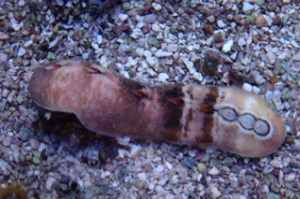
|
|
Found this on the beach 12/20/15
Hey crew, I found the shell on a beach (Port Elizabeth, South Africa) I believe
it to be an isopod, just need to know. Never saw something like it before
<Nope, not an isopod crustacean but in fact a Chiton, a mollusk and a member of
the class Polyplacophora. Fascinating creatures from an evolutionary line quite
distinct from the "higher" molluscs (gastropods, bivalves, scaphopods and
cephalopods) and retaining many primitive features, not least of which is the
segmented shell. They are actually very common and widespread, but because they
are nocturnal in habit and tend to avoid light they are not always obvious. Turn
over rocks and seaweed to find them. Cheers, Neale.>
|
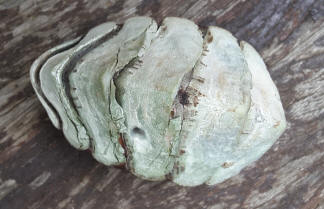
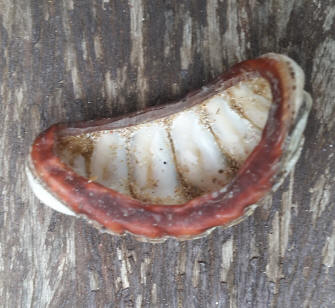 |
|
What is this?!? Pac. coast Chiton
11/26/14
Hi folks -
<Brian>
We found this creature on the sand on the coast at Arch Rock in Point
Reyes National Seashore, California. As you can see, it has some size to
it.
The speckles are dark sand grains. The flesh is light yellowish orange.
Is this a Chiton of some sort? The shiny plates are "boney"; the rest is
slightly soft to the touch and flesh-like. Is it intact?
<Mmm; yes this appears to be a Gumboot or Giant Western Chiton,
Cryptochiton stelleri>
Thanks!
Brian Bean
<Thank you for sharing. Bob Fenner>
|
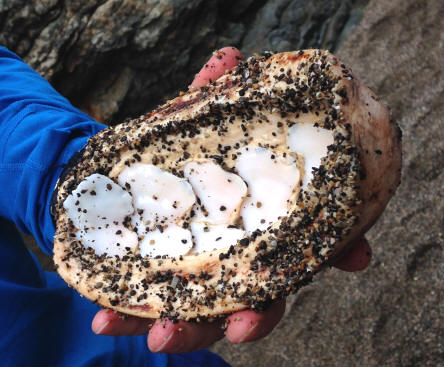 |
|
Invert ID?
10/21/13
Hey guys! We've found a new dude in our salt water reef tank recently,
and we're not even entirely sure what category of invert he might be.
>Ohhh, I am<
I've posted three pictures here:
http://www.flickr.com/photos/slw71881/sets/72157636784527453/
He's too tall to be a flatworm, too angular for a sea cucumber, doesn't
match any Nudibranch I can find, etc. We have Chitons in our
tank that also hitchhiked in, but this guy is soft-bodied, no shell.
<Is a Chiton likely... just young>
I've seen PART of his body but not all -- the part I've seen is about an
1.25" long and 3/8 of an inch wide, and at least a quarter inch tall.
There are at least four of those multicolor dots on his back. He's not
flat, although he can flatten out when he wants to, but he's almost
trapezoidal in shape. He's looks creamy under the actinics, and pinkish
under our daylight lights. He moves like a turbo snail, but I haven't
been able to figure out if the part I'm seeing is his head or tail or
something more
like a starfish arm. Any thoughts? We're quite impressed by him,
and he seems to be happy, but not sure if he's friend or foe or how big
he might get.
Thanks!
Susan Weston
<Am pretty sure this is a Polyplacophoran. Thanks for sharing. Bob
Fenner>
|
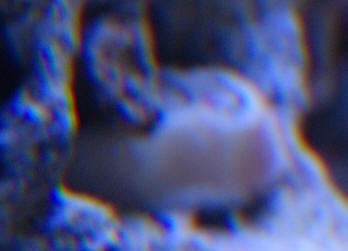 |
Re: Invert ID? 10/21/13
Fascinating! You are, as always, a wealth of information -- thank you!
<Welcome! BobF> |
Snail ID: Possible Limpet – 8/29/13
I found this "little" guy in a reef system and was wondering what it
might be. He flattens out like a limpet and looks like a giant limpet.
<What I can see does look akin to a limpet but there are a couple of
other possibilities as well. I’d need to see a detailed photo
showing the top surface of the shell in order to have a better shot at
an ID.>
When flattened out it is almost 2" in length.
<What size is that actual shell? In the photo, it looks just a bit
larger than the penny (= ¾”), so I’m guessing it’s close to an inch
across. Is that about right? Also, is there a hole in the
top of the shell? Any and all information helps! In
the meantime, do look through our limpet FAQ’s for more information and
photos, starting here:
http://www.wetwebmedia.com/MolluscPIX/Gastropods/Prosobranch%20PIX/Limpets%20Scutus/LimpetF1.htm
Take care, Lynn Z>
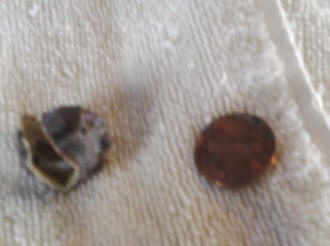 |
Re: Snail ID: Possible Limpet
- Nope: Polyplacophoran/Chiton! 8/30/13
In that picture, the snail is curled up. The top of the shell is sectioned
line armored scales to allow the snail to be flexible.
<Gotcha, thanks; that changes everything!>
When stretched out it is about 2" in length and 1" wide. Also, it was nearly
impossible to get off the side of the tank. It can move at about the speed
of a Turbo Snail.
<Sounds like you’ve got a beneficial grazer called a Chiton/Polyplacophoran.
Please see WWM for more information, starting here:
http://www.wetwebmedia.com/chitonfaqs.htm?h=
If that’s not what you have, do send along a few more photos and we’ll give
it another go! Take care, Lynn Z>
Re:
Snail ID: Possible Limpet - Nope: Polyplacophoran/Chiton! 8/31/13
Ah, very good thank you for your help.
<You’re very welcome.>
One question further. I know that they are mostly herbivores, however there
are a few predatory species.
<Yes, there are – as well as others besides. Chitons run the gamut
from being herbivores, detritivores, carnivores or even omnivores.
Thankfully, the hitchhikers we tend to run across are beneficial,
herbivorous, hard-surface grazers of diatoms and/or coralline algae.
The biggest concern with these is the possibility of them leaving rasp marks
in an acrylic tank. It should be noted, that even these herbivorous
species can be incidental consumers of the various tiny critters (‘pods,
worms, and such) they run across, so in essence, they could technically be
considered omnivorous. The good news is that they’re not actively
trying to find and eat the critters, they just happen to be in the way while
grazing. As for the true carnivores, they consume a variety of
foods from various ’pods to Foraminiferans, Ostracods, worms, sponges,
crustaceans, fishes, etc.. The smaller, slower prey items are
generally obtained by simply mowing over and consuming any that are in the
Chiton's path, while larger, faster prey can typically be either ambushed,
or enticed and trapped, by use of an enlarged anterior girdle area. >
I'm guessing mine is not of the predatory variety due to the lack of an
enlarged mantle?
<That’s right – at least it’s not one of the big-time predators, like those
in the genus Placiphorella. There are other carnivorous Chitons,
however, that do not have that enlarged anterior girdle. That being
said, I wouldn’t worry a bit about your individual. I’ve never seen,
or heard of, any hitchhiking Chiton that posed any sort of threat to major
livestock. I say enjoy it for as long as it’s around! By the way, I
have a couple of links for you that you might find interesting/helpful.
The first is a good basic article while the second is a paper that relates
to diet. It’s probably more than you ever wanted to know about what
Chitons eat, but it’s interesting!
http://biology.fullerton.edu/deernisse/pubs/Eernisse_07_chitons_Tidepools.pdf
http://mollus.oxfordjournals.org/content/70/3/225.full.pdf
Take care, Lynn Z>
|
|
Can you ID this please? 4/26/13
Hi- I saw this thing on my live rock a few weeks back but couldn't remove
it(110 reef tank).
<Mmm, yes; Polyplacophorans are hard to dislodge>
I came back the next day and it wasn't there. I saw it again last night and
able to take a few photos. I was finally able to prior it off the rock with
a metal knife but it was holding on to the rock like glue(very hard to
remove). It is flat with rippled exoskeleton/shell like a beetle. It is
almost like a snail on its underside. It reminds me of some type bristle
worm but none like I have ever seen before. It curled up like a ball once I
removed it. Any help you could provide would be great. Thanks Ron
<See here:
http://www.wetwebmedia.com/chitonidf.htm
Bob Fenner>
|
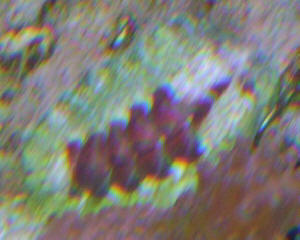
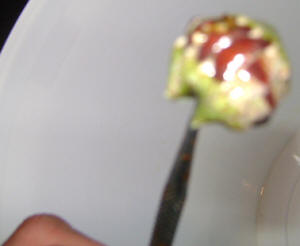 |
|
Yes, and ID question.... sorry
3/27/13
You California guys have much info on this????
Adam
<What is that? Renilla? BobF>
|
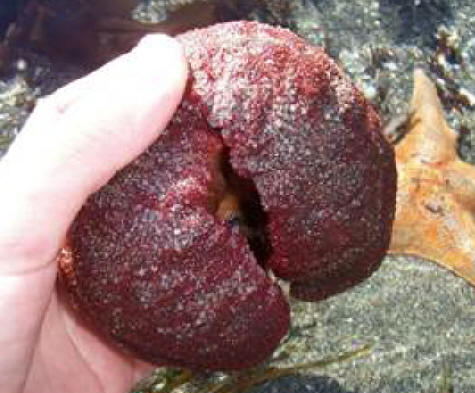 |
Identification attempt for 3/27/13 creature
*Yes, and ID question.... sorry 3/27/13*
You California guys have much info on this????
Adam
<What is that? Renilla? BobF>
hello! I thought I might offer a guess as to what this creature might be. My
guess is that this is a Chiton, maybe
Cryptochiton stelleri; the colours and shape seem to match.
Emilie
<<Ah yes Emilie. Please see LynnZ's input below. BobF>>
Hey Bob! I think the critter in question is Cryptochiton stelleri, aka
the Gumboot Chiton. Here's a link with a photo/info:
http://seanet.stanford.edu/OtherMolluscs/#Cryptochiton_stelleri .
Hope that helps!
Take care,
-Lynn Re: Identification attempt for 3/27/13
creature, Chiton 3/28/13
Oh sorry! Next time I'll let you guys do what you're best at! I didn't mean
to butt in! No response necessary, have a good day!
<Ah, no; thank you for your input/sharing. BobF>
|
|
ID
10/8/12
Mr. Fenner
I was hoping you could identify this little guy for me. Thanks for your
time.
<Mmm, from this pic... maybe a Polyplacophoran.... or an Echiuran... is
it segmented? Bob Fenner>
|
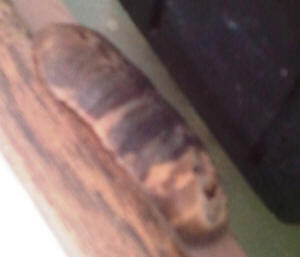 |
Re: Mr. Fenner
10/8/12
It was some kind of shell-less snail type critter - had a single slimy foot
when I flipped it over.
<Ahh, a Chiton then almost for sure. BobF>
Re: Mr. Fenner
10/8/12
As in no segments sir. Thank you!
<Ahh, they are embedded dorsally... Welcome. B> |
|
Critter ID: Chiton, Cryptoplax spp. – 8/13/12
Crew:
<Hi Michele, Lynn here this evening.>
Thanks as always for the help!
<You’re very welcome!>
Any idea on identifying this critter?
<Yep, it’s a harmless Polyplacophoran, aka a Chiton, most likely in the
genus Cryptoplax. These are nocturnal, herbivorous, hard surface
grazers that pose no threat (predation-wise) to your other livestock.
Please see the following link for photos of several species, one of
which (Cryptoplax larvaeformis) is one that seems to pop up fairly often
a hitchhiker:
http://www.poppe-images.com/?t=11&family=CRYPTOPLACIDAE&fullspecies=&locality=&latest=&phylum=&class=&comname=&catid=53
>
This guy appeared in the filter sock of our 250 gallon reef.
<Neat>
No new rock has been added in over 4 years so it's presumably been in
there at least that long. We've occasionally caught glimpses of it in
the main tank on the glass through the years. It's currently about 3
inches in length but can expand to at least 5 inches. The diameter
and height are about 3/4 inch.
<That sounds about right. Cryptoplax species tend to be more
worm-like in appearance than most other genera.>
We thought sea hare at first but it doesn't appear to have rhinophores.
<Nope, no rhinophores on these guys!>
It resembles pictures of a planarian,
<I’m not sure why, but those things have always given me the creeps.>
…but the head is not arrow shaped and this guy is huge!
<Oh yeah, these guys can get pretty big. If what you have is C.
larvaeformis, it should top out at around 6”/15cm. This size could
be problematic in a small system, but your 240g should be fine.>
The dorsal aspect is hard and the feeding apparatus appears to be on the
ventrum.
<Yep>
It's quite pretty but we are concerned if it is reef safe
<Thankfully, your livestock is not on the Chiton’s menu but there is the
possibility that due to its size, the animal may, on occasion, dislodge
a frag, rock, or the like, as it forages at night.>
…and if it could potentially release toxins.
<Nope, no toxins, so no worries there.>
It's currently in a frag tank.
<I’d put it back in the 240g and enjoy seeing it now and again.
Please see the following links for more information regarding Chitons:
http://www.wetwebmedia.com/chitonidf.htm?h
http://wetwebmediaforum.com/showthread.php?293-Critter-of-the-Week-Chitons!&daysprune=-1
>
Any ideas are greatly appreciated!
Thanks!
<It was a pleasure!>
Michele.
<Take care, Lynn Z>
|
 |
|
|

